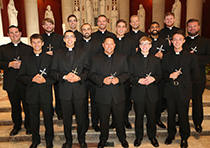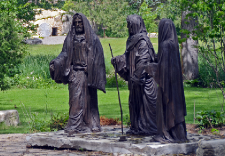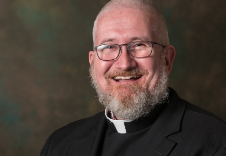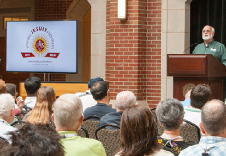
2017 Novices after their first vows Mass |
15 Jesuit novices of the USA Midwest Province proclaimed first vows — their first public profession of commitment to the Society of Jesus — at Saint Thomas More Catholic Church in St. Paul, Minnesota, on August 12.
A novice spends two years at the novitiate for the first stage of Jesuit formation, which then culminates in first vows. Each Jesuit makes the proclamation of vows individually in front of the Eucharist, just as St. Ignatius of Loyola, founder of the Jesuits, and some of his first companions did. They also receive a vow cross that they will keep for the rest of their lives.
By the time a novice kneels at the altar to pronounce vows, he is prepared, says Fr. William O’Brien, SJ, director of the Jesuit Novitiate of St. Alberto Hurtado in St. Paul, Minnesota. “As he speaks the final words of the vow formula to God, he does so with complete trust.”
The 15 Midwest Jesuits were part of a total of 36 novices from the United States, Canada, and Haiti who proclaimed the vows of poverty, chastity, and obedience in August. Following the profession of first vows, Jesuits preparing to be priests usually begin three years of studies: two years of philosophy studies, combined with one year of graduate-level theology courses. Those men who took vows as a Jesuit brother will usually take several theology courses and work on an advanced degree in a field of interest.

Jesus and the two disciples on the road to Emmaus |
A new distinctive prayer space graces the grounds of Manresa Jesuit Retreat House in Bloomfield Hills, Michigan, with three life-size bronze statues of Jesus and two disciples on the road to Emmaus. Behind Jesus’ shoulder is a replica of his empty tomb, complementing the theme of the Risen Christ. Completed May 25 and dedicated in the fall, the new station joins Manresa’s 14 other outdoor stations, which were restored in 2012.
The idea to add a 15th station originated with members of Manresa’s leadership team and board member Isaac Hanna. Thanks to the commitment of two generous donors, plans were quickly underway, with landscape architect/builder Jeff White commissioned to design and install the tomb and Emmaus sites and sculptor Reni Stephan commissioned to fashion the three figures. Father Fran Daly, SJ, executive director of Manresa, dedicated the empty tomb on June 3, 2016.
“We are so pleased to offer retreatants and visitors this place to quietly meditate on Christ’s resurrection,” said Fr. Daly. “And we are especially grateful to those donors who made this added station a reality.”
Visit www.manresa-sj.org or www.jesuitsmidwest.org/Retreat-Ministries to learn more about Manresa and other Midwest Jesuit retreat centers.

Jesuits magazine won several CPA awards |
Jesuits magazine, a publication of the USA Midwest Province of the Society of Jesus, won several Catholic Press Association (CPA) Awards, including first place for Magazine/Newsletter of the Year: Religious Order Magazine and first place for “Social Entrepreneurship: Not Just Business as Usual” in the Best Feature Article: Religious Order Magazine category. The awards celebrate Catholic journalism published in 2016.
“Exceptionally informative and interesting,” wrote the CPA Awards committee about Jesuits. “This magazine uses a variety of methods to tell its stories, and those stories are sharply honed to pass on good writing.”
The award for Magazine/Newsletter of the Year follows the Midwest Jesuits’ redesign of their magazine to prepare for the Chicago-Detroit and Wisconsin Provinces joining to become the USA Midwest Province. The magazine took second place for Best Redesign.
Other awards included honorable mentions for “Band of Brothers,” an article about Fr. Vincent Strand, SJ, and his two brothers sharing a vocation to the priesthood, in the Best Reporting on Vocations to Priesthood, Religious Life, or Diaconate category and “The Audacity to Seek the Impossible,” an article about Jesuit Fr. Arturo Sosa’s election as 31st Superior General of the Society of Jesus, in the Best Layout of Article or Column: Religious Order Magazine category.

Fr. William Blazek, SJ |
Father William Blazek, SJ, was appointed US director of the Pope’s Worldwide Prayer Network (PWPN) in June 2017, succeeding Fr. James Kubicki, SJ, who served 14 years in the role. Founded as the Apostleship of Prayer and recently renamed by Pope Francis, PWPN communicates the pope’s monthly prayer intentions to 50 million members in 89 countries, with a youth branch — the Eucharistic Youth Movement (EYM) — in 56 countries. Membership in PWPN, which is available at www.popesprayerusa.net, involves “a commitment to offer yourself to God for his purposes each day.”
The network traces its roots to France in 1844, where a group of Jesuit seminarians, anxious to hurry their studies so they could set out as missionaries, were instructed by their spiritual director to use their time and talents to save souls as “apostles of prayer.” In 1879, the group received its first statutes, approved by Pope Pius IX. In addition to sharing the pope’s prayer intentions, PWPN also maintains a devotion to the Sacred Heart of Jesus and has been entrusted by the pope to the Jesuits.
PWPN has made use of new technology to further its mission. Last year, it launched “The Pope Video,” a monthly video that shares the pope’s prayer intentions, and “Click to Pray,” an app that offers users a digital way to accompany Pope Francis in his intentions.

The Midwest Jesuits have been active in Native American ministry since 1881. |
On May 2, 2017, St. Francis Mission returned 525 acres of unused Church land to the Rosebud Sioux Tribe on the Rosebud Indian Reservation in south-central South Dakota. A Jesuit ministry among 20,000 Lakota (Sioux) people, St. Francis Mission was founded in 1886 and consists of six parishes and a number of health, education, and communication ministries.
“Saint Francis Mission should not continue to hold land that it is no longer using for Church purposes,” said Fr. John Hatcher, SJ, former president of St. Francis Mission. “I am grateful to the Rosebud Sioux Tribe for the use of this land and happy that we can return it for the use of the Lakota people.”
In 1881, Chief Spotted Tail invited Jesuit priests to educate the Lakota people. The federal government and the Rosebud Sioux Tribe granted the mission land to support a school and to construct churches and cemeteries throughout the reservation. Eventually, 23 mission stations were built, some encompassing as much as 40 to 80 acres of land to support Native catechists and their families. As the Native population moved from the prairie into cluster housing, churches closed, while the mission retained possession of the land.
Through the proactive efforts of the mission, the Rosebud Sioux Tribe, and the Bureau of Indian Affairs, all unused land will be returned except for places in which the mission has active operations.

Fr. Gregory Boyle, SJ, speaks at WUJA |
For the first time ever, the World Union of Jesuit Alumni (WUJA) Congress was held in North America at John Carroll University in University Heights, Ohio, from June 28 to July 2, 2017.
The gathering brought together roughly 500 people representing Jesuit schools, parishes, and ministries from 27 countries. The official theme was “Uniting Our Jesuit Frontiers.”
WUJA was founded in 1956 in Bilbao, Spain, to commemorate the 400th anniversary of the death of St. Ignatius of Loyola. The organization gathers Jesuit alumni to build international networks and discern how to promote peace and justice in a global and sustainable world. The three-day program featured about 30 breakout sessions on topics ranging from the arts, business, medical science, and law to spirituality, service, and leadership. It also featured roughly 60 speakers, including
Fr. Timothy Kesicki, SJ, president of the Jesuit Conference of Canada and the United States, and best-selling authors Chris Lowney and Fr. James Martin, SJ.
“It’s awesome to see that people who have already graduated still have the same action and enthusiasm surrounding being Jesuit educated that I do,” said Lauren Dickerson, a student at Wheeling Jesuit University.
Return to the Jesuits Magazine Fall Winter 2017 Magazine Index